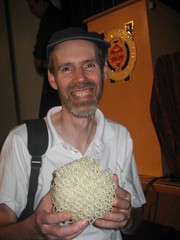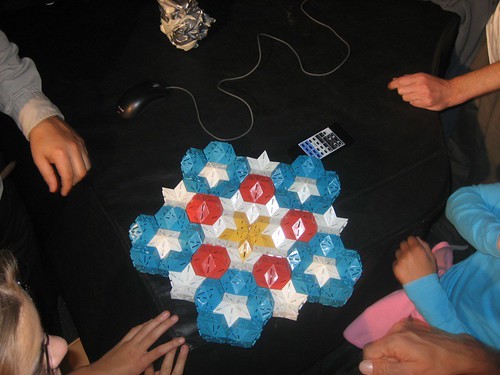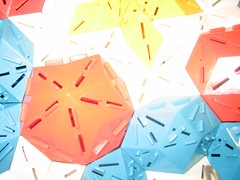it just proves that you should not trust results unless they are formally proved". Allelouia! Finally a physicist saw the light!!! ;) [Edit 2006/09/18: Although by saying so, he once again claim a "proof" which isn't one, merely an example...] His talk was very good, reaching scientists as well as children, with several sessions with a webcam pointed from above to a brightly lighted table, allowing him to do live demonstrations. I heard about it but that's the first I saw. I would like to have one in class, and it would certainly be a must for video conferences. Does not seem expensive, we should see them arrive soon at the university. He also exhibited a 3d construction obtained through a "3d printer", which you can see on the picture on the side, hold by another Paul. I heard about those 3d printers, but again that was the first time I saw for real an objected thus created. I guess we will wait long before we get those at the University though... One thing excited me a lot. The quasicrystals are based on a relaxation of the definition of a crystal, which permit materials with similar or stronger properties than crystals. The main arguments against their real existence, as opposed to a theoretical object, was that to create them one would need non-local rules. This was ultimately solved by finding a set of local rules allowing to create quasicrystals. You can see an example of how those local rules are implemented in the real world on the pictures on the right: the notches identify the faces and forbid some alignments, forbidding local moves which could result in a contradiction in the global construction. I had the same problem with the Bak Sneppen model, a model of evolution on which I worked for quite a while: we have a model with nice properties, which could explain many things in Nature, but it uses non local rules, so that detractors claim that this model can't be true. I asked Paul Steinhardt if he knew some mathematical analysis of quasicrystals, so that I could try to apply their analysis in space time rather than in the 3 geometric dimension, but he claims that mathematicians refuse to work on those. He made me wanting to look more at this problem, I will do some more bibliography! [Edit 2006/09/18: Of course, there is a large bibliography in Mathematics about such processes, and that actually I knew some of it...] The video of the talk should soon be uploaded on the mediasite of the Perimeter Institute, and you can read the abstract of the talk.
2006/09/07
[Science] Quasicrystals
I saw an awesome talk yesterday, part of the series organized by the Perimeter Institute.
Paul Steinhardt is a famous physicist from Princeton. He described the history of the research on "quasicrystals", how it went from the status of an impossibility, then to the status of a theoretical possibility, to finally reach the status of a admitted fact, with at each step some people (physicists) claiming that the next step was impossible. I appreciate to its right value the remark from Paul when I chatted with him after the talk: "
Subscribe to:
Post Comments (Atom)





No comments:
Post a Comment